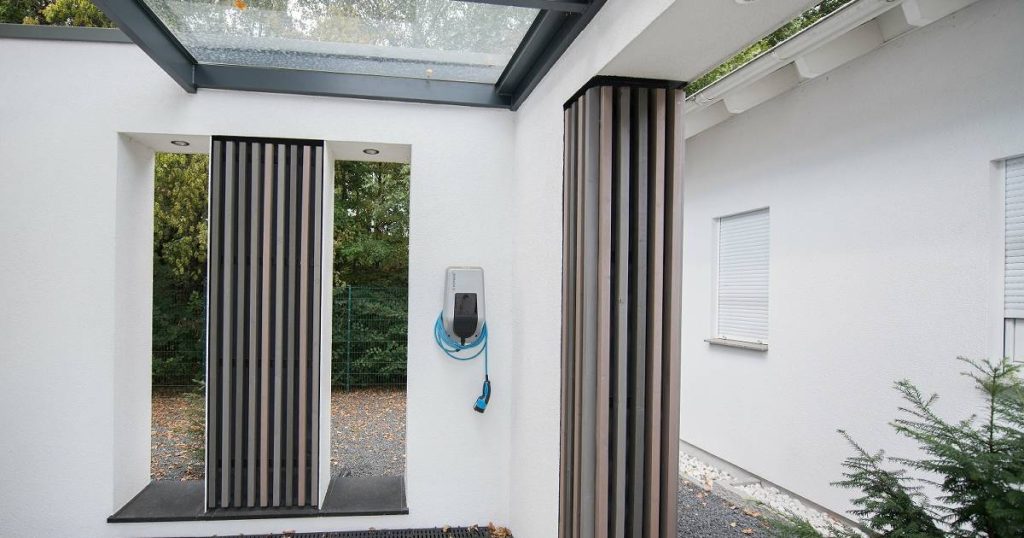Shipping boxes
:
Find your home charging station
;)
Small charging stations for electronic cars can be installed inconspicuously in the garage or in the garage.
Photo: dpa-tmn / Andrea Warnecke
Electric cars are selling better and better. Before making any decision, you should consider the right shipping option. Find out how to install them.
Electric cars run without any local emissions and are filled with electricity from the socket. Only: if you update the battery in the household socket, you have to be patient. Charging often takes hours, so overnight is recommended. So a wall box can be a good alternative.
Who is suitable for a wall box?
Wall boxes make sense for hy- plug-in owners.
Bridge cars and electronic cars that have a garage or a private parking place with electricity. “By using the wall box, the owner of the e-car increases the comfort of operation. He gets into a fully charged car every morning,” says Christian Forster, e-mobility expert at Tov Nord.
What are the advantages of a wall charger?
To fill your garage: There are many wall boxes that can be installed in private homes.
Photo: dpa-tmn / dpa-infographic GmbH
Wall boxes greatly speed up the shipping process. For comparison: For example, with 2.7 kilowatt-hours (kWh) and ten amperes tuned in, it takes more than ten hours to fill a 30-kilowatt-hour battery. “They are specifically designed for high DC,” says Matt-
Theias Vogt on the wall boxes. Vogt Shipping Expert
Infrastructure at the ADAC Technical Center in Landsberg am Lech. Modern systems communicate not only with the car, but also with the network operator. For example, peak charging should be avoided when there is a risk of overloading the power grid. Plus, according to TÜV, charging via a wall box is safer than charging via a home socket.
Why can charging from a household socket become dangerous?
The long charging time always puts pressure on the local power grid. “High current flows for a long time through an electrical system that is not designed for this purpose,” explains Oliver Fox, owner of a company specializing in electronic mobility in Siegburg, near Bonn. Overloading can cause a short circuit or even a fire.
What performance should wallbox have?
Experts recommend an 11 kW system that can charge the battery in three stages. “Wall boxes with a charging capacity of 11 kilowatts fully charge the vast majority of batteries overnight,” Fuchs says. Usually three kilowatts is enough to refuel the daily electricity needs of an electric car overnight. Customers can also choose 22 kW boxes, but they are more expensive and damage the battery more quickly due to the higher charging speed. Wall boxes of 3.6 kW are also available.
Does every wall box fit every electronic car?
Basically yes. However, potential buyers should pay attention to the e-car’s onboard charger. “Depending on the vehicle, the battery is charged only in one stage,” says TÜV expert Christian Forster – which lengthens the charging process. Thus, more modern electronic cars incorporate two- or three-phase chargers on board. Plug types are now unproblematic, and the confusion of days past has largely been resolved: in Europe, wall boxes were fitted with a Type 2 plug as standard, also known as a Mennekes plug.
You need to invest around 400 euros to buy simple hardware, but you can also spend up to about 2500 euros. In addition to this, electricity installation costs
trofachbetrieb: If you have a charging station connected only to a three-phase connection, you have to add a few hundred euros. If the entire home connection had to be rewired, the installation alone could cost several thousand euros. However, charging points of 900 euros each can be supported by the country.
What should electric vehicle drivers consider when buying a wall charger?
Before buying, interested parties should clarify how much charging power the wallbox should have, where it will be installed and whether the installation is possible. The choice of the right wall box depends on the individual situation and wishes, so some models can be controlled via a smartphone application. According to Matthias Vogt, charging points of up to 11 kW only require notification and do not require approval – reducing bureaucratic effort.
Where should the wallbox be installed?
Best in the garage or garage. If installed outside, the wall box should be protected from wind and weather and not exposed to direct sunlight. “In extreme temperatures, this can reduce charging capacity,” the ADAC technician Vogt explains. Also important: With the box’s charging cable, you should be able to easily access the car’s charging socket. And you should make time: according to Engineer Fox, preparation and installation may take several months.
Can anyone simply install a wall box?
Individuals and businesses can have a wall device installed on their property. In the case of joint ownership, the consent of the other owners is required. According to the Home Ownership Act (WEG), apartment complex owners can claim to be allowed to build a charging station for their electric vehicles, even against the will of the co-owners (Article 20 Paragraph 2 WEG). Tenants can have a wall box installed with the consent of the landlord.

“Problem solver. Proud twitter specialist. Travel aficionado. Introvert. Coffee trailblazer. Professional zombie ninja. Extreme gamer.”




; background-size: contain; object-fit: contain)
More Stories
Below is the schedule of pension payments as of July 2022. Find out what benefits you will get after the changes [17.07.2022]
Overview of the new electric sports cars for the Hyundai Ioniq 5 N and Ioniq 6 N
Portugal has launched a floating solar power plant. It is the largest structure of this type in Europe – Economy